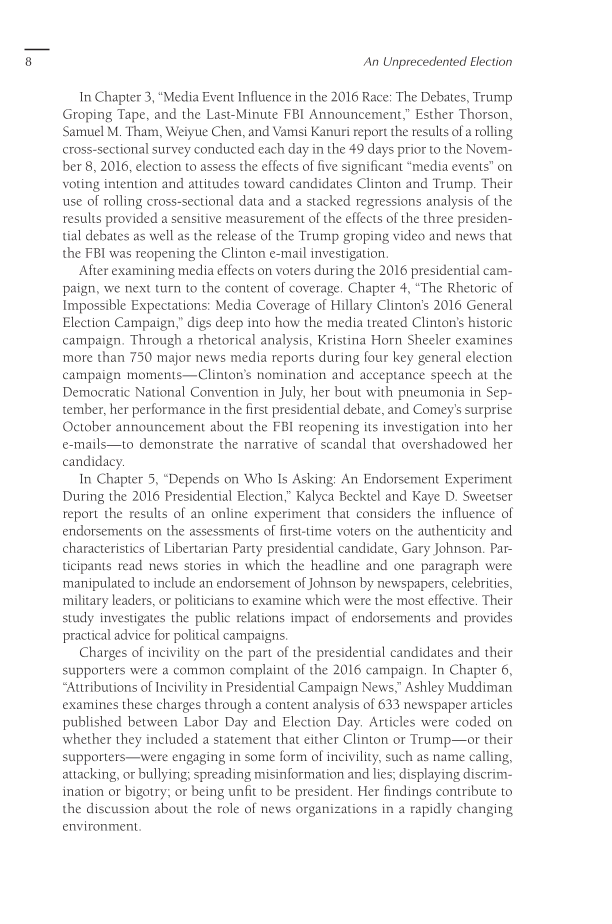8 An Unprecedented Election In Chapter 3, “Media Event Influence in the 2016 Race: The Debates, Trump Groping Tape, and the Last-Minute FBI Announcement,” Esther Thorson, Samuel M. Tham, Weiyue Chen, and Vamsi Kanuri report the results of a rolling cross-sectional survey conducted each day in the 49 days prior to the Novem- ber 8, 2016, election to assess the effects of five significant “media events” on voting intention and attitudes toward candidates Clinton and Trump. Their use of rolling cross-sectional data and a stacked regressions analysis of the results provided a sensitive measurement of the effects of the three presiden- tial debates as well as the release of the Trump groping video and news that the FBI was reopening the Clinton e-mail investigation. After examining media effects on voters during the 2016 presidential cam- paign, we next turn to the content of coverage. Chapter 4, “The Rhetoric of Impossible Expectations: Media Coverage of Hillary Clinton’s 2016 General Election Campaign,” digs deep into how the media treated Clinton’s historic campaign. Through a rhetorical analysis, Kristina Horn Sheeler examines more than 750 major news media reports during four key general election campaign moments—Clinton’s nomination and acceptance speech at the Democratic National Convention in July, her bout with pneumonia in Sep- tember, her performance in the first presidential debate, and Comey’s surprise October announcement about the FBI reopening its investigation into her e-mails—to demonstrate the narrative of scandal that overshadowed her candidacy. In Chapter 5, “Depends on Who Is Asking: An Endorsement Experiment During the 2016 Presidential Election,” Kalyca Becktel and Kaye D. Sweetser report the results of an online experiment that considers the influence of endorsements on the assessments of first-time voters on the authenticity and characteristics of Libertarian Party presidential candidate, Gary Johnson. Par- ticipants read news stories in which the headline and one paragraph were manipulated to include an endorsement of Johnson by newspapers, celebrities, military leaders, or politicians to examine which were the most effective. Their study investigates the public relations impact of endorsements and provides practical advice for political campaigns. Charges of incivility on the part of the presidential candidates and their supporters were a common complaint of the 2016 campaign. In Chapter 6, “Attributions of Incivility in Presidential Campaign News,” Ashley Muddiman examines these charges through a content analysis of 633 newspaper articles between Labor Day and Election Day. Articles were coded on published whether they included a statement that either Clinton or Trump—or their supporters—were engaging in some form of incivility, such as name calling, attacking, or bullying spreading misinformation and lies displaying discrim- ination or bigotry or being unfit to be president. Her findings contribute to the discussion about the role of news organizations in a rapidly changing environment.
Document Details My Account Print multiple pages
Print
You have printed 0 times in the last 24 hours.
Your print count will reset on at .
You may print 0 more time(s) before then.
You may print a maximum of 0 pages at a time.









































































































































































































































































































































































































































































